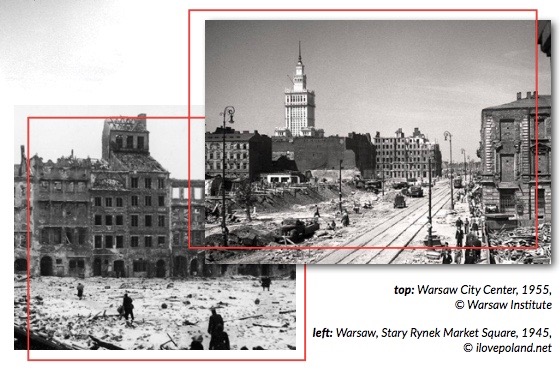The year 2019, or the last year of the “before times’’, marked 100 years since Poland and Romania officially established diplomatic relations. Poland was the first state to recognize the unification with Transylvania, making the two Central and Eastern Europe’s largest population pools. And what a century it has been! Both countries have rich histories, spanning feudal societies, monarchies shattered and reborn, several decades under the iron first of communism, all culminating with the modern post 1989 era of democratic rule and gradual internationalization. All these historical shifts left a cookie trail of architectural and infrastructure influences, resulting in a true mosaic of the countries’ respective real estate industries.
Allow us to take you on a brief walking tour of the two countries’ capitals and fast growing secondary cities, as part of the present business assessment study that looks over the residential, retail, industrial and office segments alike. The pandemic that we are all still navigating naturally had wildly differing effects on them, that are still rippling through the industry segments, but by and large after a few months of “wait and see” businesses forged ahead, even thriving in areas such as residential and industrial. Poland has been in the limelight more than Romania, however, by speaking to over 100 savvy developers, investors and key service providers, our conclusions clearly show that both countries’ property markets are still investment-wise diamonds in the rough, with demand increasingly outstripping supply.
In order to understand Poland’s and Romania’s property and infrastructure evolution, let’s take a quick look at their main real estate hubs - their capital cities. From a bird’s eye view Bucharest and Warsaw can have a similar vibe with their large communist style boulevards and grey- tinted, imposing buildings, mixed with historical and patrimony ones, meandering streets and roundabouts. But upon entering Warsaw one is immediately hit by the city’s impressive, US reminiscent skyline, testament to the country’s swift economic overhaul of the past three decades, well ahead of Romania’s that in certain ways looks at Poland as a mirror to the future. This is mainly due to the latter's success in attracting foreign capital, absorbing EU funding and developing a robust Central Business District and dynamic industrial ecosystem.
BUCHAREST: A City of Contrats
Bucharest went through a flourishing period in the 19th century, when Western style influences combining romanticism and neoclassical elements earned it the “Little Paris” label, boasting its very own Arch of Triumph. Emblematic buildings such as the Atheneum, Cantacuzino Palace, Cotroceni Palace (current presidential abode) or the Palace of Justice were erected during this period. The city kept developing in the interwar period, with Art Deco buildings such as the Telephone Palace and functionalist ones like the Bucharest North Railway station or the National Bank of Romania taking shape.

The second half of the 20th century bore the mark of Ceaușescu’s communist ideals, building up residential neighbourhoods to accommodate the cities’ fast paced industrialization and igniting a wave of urban migration. His visits to North Korea and China birthed ambitions of wide boulevards and buildings such as the grandiose Palace of Parliament, to this date the largest administrative building in the world after the Pentagon, for which many of Southern Bucharest’s historical buildings and center had to be demolished and much of the city rebuilt. The main feature of this epoch, however, are the dull, solemn and cramped blocks of flats, whose future is boggling the minds of present day urban planners.

The post communist era spanning the past three decades witnessed the rise of glass and steel architecture and the (slow, initially Wild West style in the 1990s) rise of office buildings, malls and retails centers, modern residential buildings, and more recently industrial and logistic centers in the city’s outskirts. This is a period marked by heavy privatization and foreign investment, accelerated by the country’s joining of the EU in 2007. The saying goes that out of chaos beauty is born - and as poetic as that sounds, Bucharest’s story finds us in 2021 in the midst of a jumble of eager, not always well integrated construction projects, and authorities that bear on their shoulders the mission of rethinking the city’s overall urban development future.
WARSAW: The Indestructible Phoenix
Warsaw is notable among Europe’s capital cities not so much for its size, its age, or its beauty but for its indestructibility. It is a phoenix that has risen repeatedly from the ashes of war.

Warsaw and Poland’s urban landscape went through a swathe of historical phases, with the capital city harboring a number of stories and styles including gothic, renaissance, baroque, and neoclassical. St. John’s Cathedral from the 14th century is one of many remarkable places of worship, and baroque style beau es such as Wilanow Palace or Kazimierz Church stand as remnants of the Polish-Lithuanian kingdom.
The city went through an enlargement phase in 1916 when many housing estates popped up, housing workers, writers and army officials alike. By and large, however, Warsaw is not all that meets the eye - it suffered great losses during WWII when most of the city was bombed, and had to be rebuilt from the ashes, at times respecting buildings’ original designs, at others bending some according to socialist realist architecture.

Warsaw’s tallest building remains the (in)famous 1950s Palace of Science and Culture, a so-called Communist skyscraper that used to tower over an otherwise mostly flat city with its 230 m. The city also makes one stop and stare at the Stalinist style large boulevards and brutalist buildings. Starting with the 1990s however, the city slowly developed its own skyline, to rival that of London, Paris or Frankfurt in height and modernity. The Palace of Science and Culture’s dominance will be overthrown in 2021, when Varso Tower’s whooping 310 m will make it not only Poland’s but the entire EU’s tallest building.
This article was originally published in Real Estate in Romania & Poland 2021 report, available in full here.

